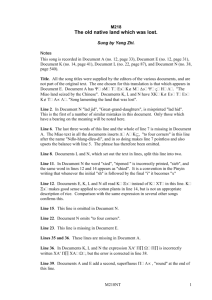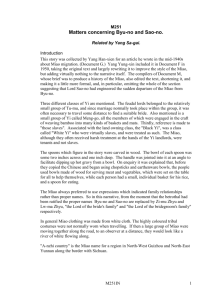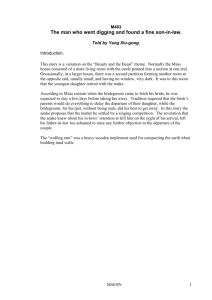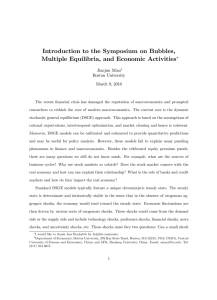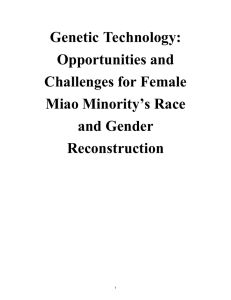Research Statement Jianjun Miao
advertisement
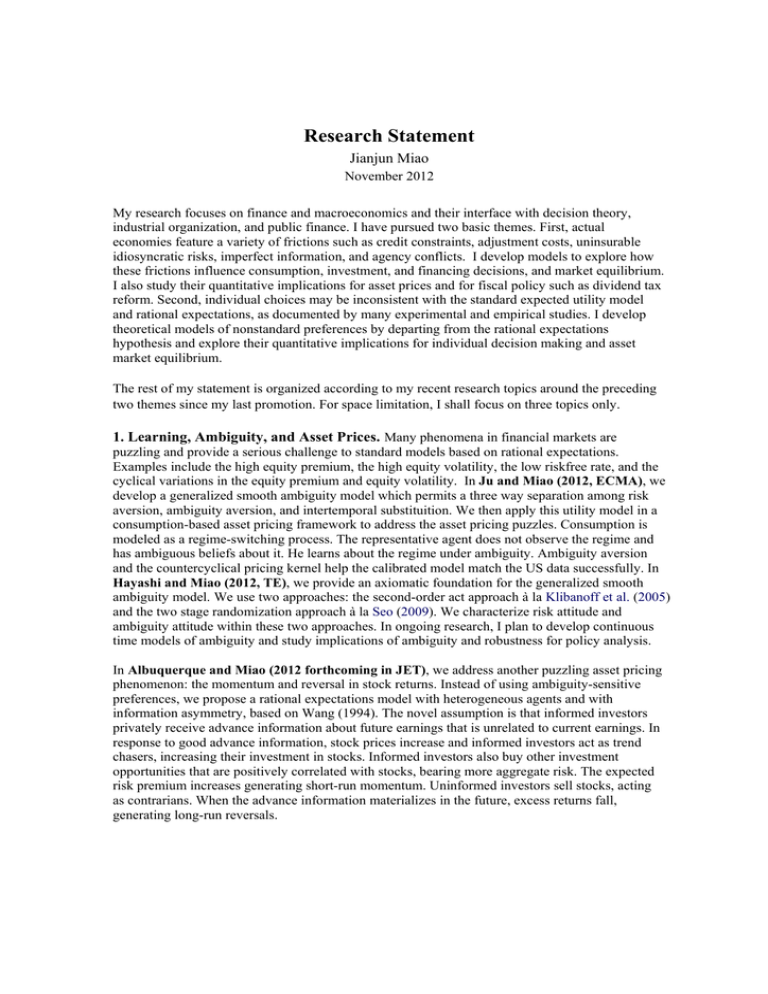
Research Statement Jianjun Miao November 2012 My research focuses on finance and macroeconomics and their interface with decision theory, industrial organization, and public finance. I have pursued two basic themes. First, actual economies feature a variety of frictions such as credit constraints, adjustment costs, uninsurable idiosyncratic risks, imperfect information, and agency conflicts. I develop models to explore how these frictions influence consumption, investment, and financing decisions, and market equilibrium. I also study their quantitative implications for asset prices and for fiscal policy such as dividend tax reform. Second, individual choices may be inconsistent with the standard expected utility model and rational expectations, as documented by many experimental and empirical studies. I develop theoretical models of nonstandard preferences by departing from the rational expectations hypothesis and explore their quantitative implications for individual decision making and asset market equilibrium. The rest of my statement is organized according to my recent research topics around the preceding two themes since my last promotion. For space limitation, I shall focus on three topics only. 1. Learning, Ambiguity, and Asset Prices. Many phenomena in financial markets are puzzling and provide a serious challenge to standard models based on rational expectations. Examples include the high equity premium, the high equity volatility, the low riskfree rate, and the cyclical variations in the equity premium and equity volatility. In Ju and Miao (2012, ECMA), we develop a generalized smooth ambiguity model which permits a three way separation among risk aversion, ambiguity aversion, and intertemporal substituition. We then apply this utility model in a consumption-based asset pricing framework to address the asset pricing puzzles. Consumption is modeled as a regime-switching process. The representative agent does not observe the regime and has ambiguous beliefs about it. He learns about the regime under ambiguity. Ambiguity aversion and the countercyclical pricing kernel help the calibrated model match the US data successfully. In Hayashi and Miao (2012, TE), we provide an axiomatic foundation for the generalized smooth ambiguity model. We use two approaches: the second-order act approach à la Klibanoff et al. (2005) and the two stage randomization approach à la Seo (2009). We characterize risk attitude and ambiguity attitude within these two approaches. In ongoing research, I plan to develop continuous time models of ambiguity and study implications of ambiguity and robustness for policy analysis. In Albuquerque and Miao (2012 forthcoming in JET), we address another puzzling asset pricing phenomenon: the momentum and reversal in stock returns. Instead of using ambiguity-sensitive preferences, we propose a rational expectations model with heterogeneous agents and with information asymmetry, based on Wang (1994). The novel assumption is that informed investors privately receive advance information about future earnings that is unrelated to current earnings. In response to good advance information, stock prices increase and informed investors act as trend chasers, increasing their investment in stocks. Informed investors also buy other investment opportunities that are positively correlated with stocks, bearing more aggregate risk. The expected risk premium increases generating short-run momentum. Uninformed investors sell stocks, acting as contrarians. When the advance information materializes in the future, excess returns fall, generating long-run reversals. 2. Taxation, Investment and Financial Policies. What is the impact of the 2003 dividend and capital gains tax reform on firm investment and financing decisions? The traditional analysis of this question is often based on a single firm partial equilibrium model. In Gourio and Miao (2011, AEJ: Macro), we propose a dynamic general equilibrium model with firm heterogeneity. We show that firms in different finance regimes respond to the tax reform in different ways. A dividend tax cut has a capital reallocation effect and raises total factor productivity. The calibrated model shows that when both dividend and capital gains tax rates are cut from 25 and 20 percent, respectively, to the same 15 percent level permanently, the aggregate long-run capital stock increases by about 4 percent. The traditional analysis of the investment and financing decisions often assumes risk neutrality or complete markets. In Chen, Miao and Wang (2011, RFS), we study a risk averse entrepreneur’s investment and financing decisions when he is exposed to non-diversified idiosyncratic risk. Risky debt provides not only a tax benefit but also a diversification benefit. Trading off between these benefits and default costs determines an entrepreneurial firm’s capital structure. We show that an entrepreneur chooses high leverage and projects with low idiosyncratic risks. The latter result provides a potential explanation for the lack of empirical and survey evidence of asset substitution and risk-shifting incentives. 3. Macroeconomic Implications of Bubbles and Crashes. The existing literature on bubbles often considers pure exchange economies or overlapping-generations models with production, in which bubbles are attached to unproductive assets or intrinsically useless assets. Such a framework is not suitable for a quantitative analysis of macroeconomic phenomena. In Miao and Wang (2012a), we develop an infinite-horizon model of production economies in which bubbles are attached to productive assets. Firms face credit constraints and idiosyncratic shocks to investment opportunities. We show that a credit-driven stock price bubble can exist due to a positive feedback loop mechanism. Intuitively, if people believe in a bubble, then it helps relax credit constraints and improve investment efficiency, thereby raising firm value and supporting the initial optimistic beliefs. Bubbles are self-fulfilling. We show that this mechanism works for both the collateral constraints and self-enforcing debt constraints. This paper provides the theoretical foundation for a series of my recent research on the macroeconomic implications of bubbles. I shall discuss three papers below. In Miao and Wang (2012b, AER), we show that a bubble can exist when firms face idiosyncratic productivity shocks and endogenous collateral constraints. The bubble can help raise TFP and its collapse leads to a fall in TFP. Can bubbles help understand business cycles and the comovement between the stock market and the real economy? In Miao, Wang and Xu (2012), we build a Bayesian DSGE model to address this question. We identify a sentiment shock which drives the movements of bubbles and is transmitted to the real economy through endogenous credit constraints. This shock explains more than 96 percent of the stock market volatility and about 25 to 45 percent of the variations in investment and output. It is the driving force behind the comovement between stock prices and macroeconomic quantities. Historical decomposition of shocks shows that the sentiment shock is the dominant force for accounting for the internet bubbles and the Great Recession. In Miao, Wang and Xu (2012), we introduce endogenous credit constraints in a search model of unemployment. These constraints generate multiple equilibria supported by self-fulfilling beliefs. A stock market bubble exists through a positive feedback loop mechanism. The collapse of the bubble tightens the credit constraints, causing firms to reduce investment and hirings. Unemployed workers are hard to find jobs generating high and persistent unemployment.
